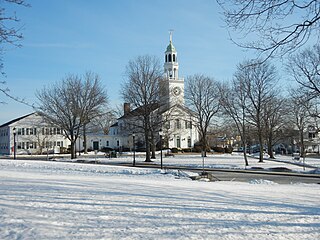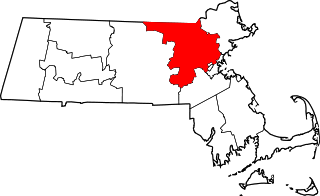
The Urban Rowhouse is an historic rowhouse 40-48 Pearl Street in Cambridge, Massachusetts. The rowhouse was constructed in a Second Empire/Mansard style in 1875, and is a contrasting example to the rowhouse on the adjacent block to providing further construction density in an urban setting. This rowhouse is of wood frame construction, while the neighboring one is built of brick. The polygonal bays rise to the mansard roof, where the shape of the bay is continued, giving visual texture to the structure.

The Boardman is a series of rowhouses at 39-53 Montana Street, occupying an entire city block between Hoosac and Blackinton Streets in North Adams, Massachusetts. The building was, at the time of its construction (1899-1901), one of the most elaborate multiunit buildings in the city, and were added to the National Register of Historic Places in 1985.

The Building at 8—22 Graves Avenue is a historic rowhouse at 8-22 Graves Avenue, just outside the downtown area of Northampton, Massachusetts. The Queen Anne style brick rowhouse was built in 1887 for Doctor Silas R. Cooley. The property is unusual because brick was not then a common building material for housing in the Connecticut River valley, and because the rowhouse style of construction was also rare in the area. The building was listed on the National Register of Historic Places in 1985.
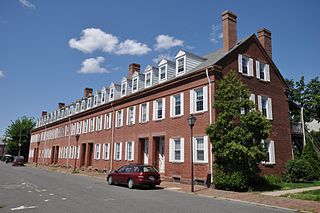
The Hadley Falls Company Housing District is a residential historic district encompassing a compact tract of factory worker housing in Holyoke, Massachusetts. Built in 1847-48, it is one of the earliest and largest surviving examples of company-built worker housing in the state. It includes five rowhouses facing Center, Lyman, Grover, and Canal Streets. The district was listed on the National Register of Historic Places in 1972.

The Downer Rowhouses are two sets of Second Empire row houses that are back to back at 55 Adams Street and 192-200 Central Street, Somerville, Massachusetts. Built c. 1880, they are among the first buildings of their type built in the city. The two groups were separately listed on the National Register of Historic Places on September 18, 1989 as Downer Rowhouses and Downer Rowhouses .
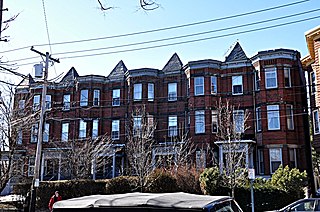
The Houses at 28–36 Beacon Street in Somerville, Massachusetts are a series of Queen Anne style brick rowhouses. The five identical houses were built c. 1880 on land formerly part of a brickyard owned by George Wyatt, whose own house stands across the street. The facade of each house is divide vertically into two sections: the left one is flat, and is topped by a square turret roof, with a single story portico sheltering double entrance doors, and the right sight is a polygonal project bay rising the full three stories. The shallow roof cornices are studded with brackets.
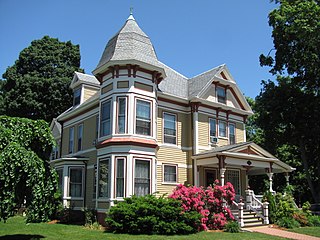
The Woburn Street Historic District of Reading, Massachusetts encompasses a two-block section of late 19th century upper-class housing. The 10-acre (4.0 ha) extends along Woburn Street from Summer Street to Temple Street, and includes sixteen houses on well-proportioned lots along an attractive tree-lined section of the street. The historic district was listed on the National Register of Historic Places in 1985.
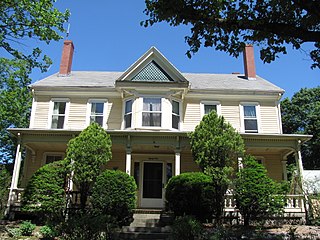
The Carter Mansion is a historic house located at 89 Woburn Street in Reading, Massachusetts.
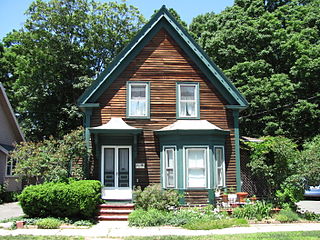
322 Haven Street in Reading, Massachusetts is well preserved cottage with Gothic and Italianate features. Built sometime before 1889, its use of even modest Gothic features is unusual in Reading, where the Gothic Revival was not particularly popular. The house was listed on the National Register of Historic Places in 1984.

The Jacob Manning House is a historic house at 140 High Street in Reading, Massachusetts. Built in 1877 for garden nursery owner Jacob Manning, this 2.5 story wood frame house is an excellent local example of Stick style architecture. It has a steeply pitched roof, multiple gables, tall thin windows, and decorative half-timber woodwoork. The owner, Jacob Manning, owned one of the largest nurseries in the area, and was responsible for the landscaping of the Massachusetts pavilion at the 1893 Chicago World Fair.

The Luther Elliott House is a historic house at 309 Haven Street in Reading, Massachusetts. This modestly sized 1.5 story wood frame house was built in 1850 by Luther Elliott, a local cabinetmaker who developed an innovative method of sawing wood veneers. The house has numerous well preserved Greek Revival features, including corner pilasters, and a front door surround with sidelight windows and pilasters supporting a tall entablature.
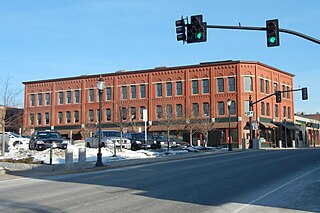
The Masonic Block is an historic commercial block at 600-622 Main Street in Reading, Massachusetts. This three story brick building is distinctive in the town for its Renaissance Revival styling. It was built in 1894 by the local Reading Masonic Temple Corporation, and housed the local Masonic lodge on the third floor. The building was listed on the National Register of Historic Places in 1984.

The Parker House is a historic house at 316 Haven Street in Reading, Massachusetts. It is a two-story wood frame cottage, two bays wide, with a front-facing gable roof, clapboard siding, and a side entrance accessed from its wraparound porch. It is a well-preserved example Queen Anne/Stick style, with high style features that are unusual for a relatively modest house size. Its front gable end is embellished with Stick style woodwork resembling half-timbering, and the porch is supported by basket-handle brackets.
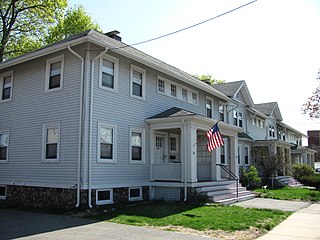
The Building at 38–48 Richardson Avenue is a historic residential rowhouse in Wakefield, Massachusetts. Built c. 1912, is believed to be one of the oldest rowhouses in the town. They were built by Solon O. Richardson, Jr., on a portion of his family's estate. The building was listed on the National Register of Historic Places in 1989.

The Buildings at 35–37 Richardson Avenue are historic rowhouses in Wakefield, Massachusetts. These two rowhouses, built c. 1912-15, are among the earliest apartment blocks built in the town. They were built by Solon O. Richardson, Jr. on a portion of his estate. The buildings were listed on the National Register of Historic Places in 1989.

The Parker House is a historic house at 52 Salem Street in Reading, Massachusetts. It is a 2 1⁄2-story vernacular Federal-style wood-frame house, five bays wide, with a side gable roof, clapboard siding, and a granite foundation. Its center entrance is particularly fine, with tall sidelight windows flanked by pilasters, and topped by an entablature with a shallow hood. The house was built in 1792, although its center chimney may date from an older house built on the site in 1715. Jonas Parker, the builder, was active in the American Revolution. A portion of Parker's farm was dedicated as Memorial Park in 1919.

Castle Street Row is a historic rowhouse block at 4-18 Castle Street in Worcester, Massachusetts. Built c. 1873 by Worcester industrialist and developer Eli Thayer, the row of 8 units is the largest collection of rowhouse units remaining in the city from a somewhat larger number built around that time. The three story brick buildings are Second Empire in style, with mansard roofs. Although they were designed as single family homes, most of them had been subdivided by the late 1880s.
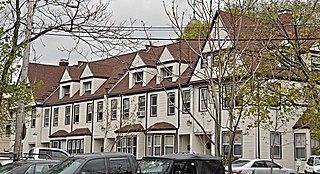
1–6 Walnut Terrace in the Newtonville village of Newton, Massachusetts is a distinctive Shingle style rowhouse. Built in 1887, it is one of the city's few examples of a 19th-century rowhouse. The building was listed on the National Register of Historic Places in 1986.

The Urban Rowhouse is an historic rowhouse located at 30-38 Pearl Street in Cambridge, Massachusetts. Built in 1874, this was one of the earliest masonry rowhouses to be built in Cambridge. Stylistically, the three story brick buildings are in a Ruskinian Gothic style, with horizontal bands of colored brick, hooded window lintels, a corbelled cornice, and a steeply-pitched mansard roof with gabled dormers.

The Urban Rowhouse is an historic residential rowhouse located at 26-32 River Street in Cambridge, Massachusetts. These rowhouses were built in 1860 by Frederick Clapp, and are among the earliest surviving examples of the type in the city. They feature a combination of brick and brownstone masonry, but also with some trim made out of wood that has been treated to appear like brownstone. They bear some resemblance to rowhouses built at the same time in Boston's South End.

